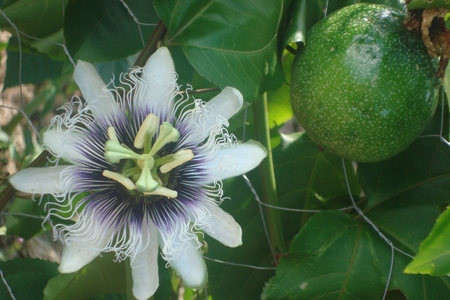
Never heard of a maypop? How about a passionflower?
Well, in many areas of the US, there is a wild fruit in season and ready to harvest. You may have seen it and never realized it was an edible plant.
What is it like?
Passiflora incarnata is a very common “weed” and a North American native. The flavor is something you would recognize. I have heard that it was the inspiration for Hawaiian Punch, though I think they taste much better than that. The variety I have tasted could easily pass for kiwi fruit. It has strong strawberry notes also.
How do I recognize it?
 The flower is very unusual. They are very easy to identify. This time of year, the flowers are just about finished, though.
The flower is very unusual. They are very easy to identify. This time of year, the flowers are just about finished, though.
This plant is often found in “disturbed soil” areas and growing up pasture fences. It is a long vine that climbs and drapes itself over other vegetation to get closer to the sunlight.
At any given time, the plant may have flowers on its lead end and fruits in many stages of development along the length of the vine.
Most varieties of the fruit are said to turn from green to yellow-orange when they are ripe, but the variety that grows wild on our property does not change color. It is very hard to determine ripeness from the rind.
A Taste-Test

We picked and cut some open to eat with lunch recently. The first one had little scent and just had dry looking white seeds. There wasn’t much to it internally.
The next two we cut open looked very different. They looked somewhat like a cross between a pomegranate and a kiwi. The flesh was the color of a kiwi, but the seeds were moist and pulpy. We scooped out the inside since the rind was a bit tough. The flavor was wonderful, but the texture was a bit less so.
We got a nice burst of flavor, but the seeds are quite crunchy, though not tooth-breaking. We were left thinking that this was probably a fruit, much like the persimmon, that would be best used for something other than fresh-eating. Jam perhaps, or maybe juice. The fruit is reported to be best cooked, while the leaves can be used as “greens.”
Why are they called “maypops”?
Maypops get their name supposedly from the joy children get stomping on them. Since this plant often trails and the fruits may fall to the ground, we have accidentally stepped on them many times in the pastures. You are startled (or rewarded?) with a sound like popping a ziptop bag and an concussion under your foot.
Other Uses
This is another wild forage plant that is quite popular with wildlife. Keeping an eye on where the vines are may provide you with hunting possibilities or maybe even lures for snares and traps.
All parts of the passionflower plant (besides the root) have long been used in Europe for treating insomnia and anxiety. It is also used as a muscle relaxant and to treat epilepsy and neuralgia.
It can be made into a tea, dried, or eaten fresh. Scientists have found that it helps in reducing the effects of drug withdrawal on addicts. It also shows promise as an anti-asthma and anti-cough medicine.
Have you ever eaten a maypop? If so, what did you think?







Trackbacks/Pingbacks
[…] Where the Wild Things Are, part 3 (Maypops) […]
[…] Where the Wild Things Are, part 3 (Maypops) Advertisement Eco World Content From Across The Internet. Featured on EcoPressed OM in the News: Water as a Sustainability Issue Share this:TwitterFacebookDiggStumbleUponEmailPrintLike this:LikeBe the first to like this post. Frontier Medicine, Health ← Baby Gear for TEOTWAWKI, part 3 (“Shelter”) […]
[…] may become a viable source of nutrition for us. Recently, we’ve shared our experiences with maypops, persimmons, dandelions, and even a […]
[…] Where the Wild Things Are, part 3 (Maypops) […]
[…] Where the Wild Things Are, part 3: Maypops […]
[…] Where the Wild Things Are, part 3 (Maypops) […]